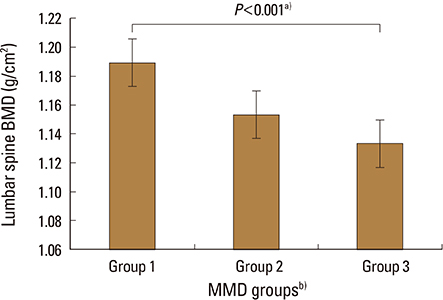J Bone Metab.
2016 May;23(2):95-100. 10.11005/jbm.2016.23.2.95.
The Association between Muscle Mass Deficits Estimated from Bioelectrical Impedance Analysis and Lumbar Spine Bone Mineral Density in Korean Adults
- Affiliations
-
- 1Department of Family Medicine, Eulji University Hospital, Daejeon, Korea.
- 2Department of Family Medicine, Eulji University School of Medicine, Daejeon, Korea. ohinia@daum.net
- KMID: 2165123
- DOI: http://doi.org/10.11005/jbm.2016.23.2.95
Abstract
- BACKGROUND
Bone mineral density (BMD) is influenced by many factors. Despite the reported association between body components and BMD, most of these studies investigated the relationship between absolute muscle mass or fat mass and BMD in postmenopausal women or elderly subjects. The aim of this study is to investigate the association between muscle mass deficits (MMD) estimated from bioelectrical impedance analysis (BIA) and lumbar spinal BMD in Korean adults 20 to 49 years of age.
METHODS
This cross-sectional study included 1,765 men and women who visited a health promotion center for a routine checkup. The lumbar spinal BMD was measured by dual energy X-ray absorptiometry. Body composition analysis was performed using BIA.
RESULTS
The mean age of the subjects was 40.2±6.3 years. Ten thousand subjects (56.7%) were males and 126 subjects (7.1%) belonged to the low BMD (Z-score ≤-2.0). MMD had the strongest influence on BMD after adjusting for all covariates. The adjusted odds ratio of Group 3 (MDD >2.6 kg) for low BMD was 2.74 (95% CI, 1.46-5.15) after adjusting for age, gender, body mass index, height, and smoking.
CONCLUSIONS
MMD estimated by BIA showed a significant association with BMD and could be regarded as an independent risk factor for low BMD in adults 20 to 49 years of age. These findings support that interventions such as physical activity or lifestyle changes may simultaneously modify both muscle and bone health in this age group.
Keyword
MeSH Terms
Figure
Reference
-
1. Felson DT, Zhang Y, Hannan MT, et al. Effects of weight and body mass index on bone mineral density in men and women: the Framingham study. J Bone Miner Res. 1993; 8:567–573.
Article2. Gourlay ML, Hammett-Stabler CA, Renner JB, et al. Associations between body composition, hormonal and lifestyle factors, bone turnover, and BMD. J Bone Metab. 2014; 21:61–68.
Article3. Kim SJ, Yang WG, Cho E, et al. Relationship between weight, body mass index and bone mineral density of lumbar spine in women. J Bone Metab. 2012; 19:95–102.
Article4. Nguyen TV, Center JR, Eisman JA. Osteoporosis in elderly men and women: effects of dietary calcium, physical activity, and body mass index. J Bone Miner Res. 2000; 15:322–331.
Article5. Liu JM, Zhao HY, Ning G, et al. Relationship between body composition and bone mineral density in healthy young and premenopausal Chinese women. Osteoporos Int. 2004; 15:238–242.
Article6. Li S, Wagner R, Holm K, et al. Relationship between soft tissue body composition and bone mass in perimenopausal women. Maturitas. 2004; 47:99–105.
Article7. Ijuin M, Douchi T, Matsuo T, et al. Difference in the effects of body composition on bone mineral density between pre- and postmenopausal women. Maturitas. 2002; 43:239–244.
Article8. Douchi T, Oki T, Nakamura S, et al. The effect of body composition on bone density in pre- and postmenopausal women. Maturitas. 1997; 27:55–60.
Article9. National Institute on Alcohol Abuse and Alcoholism. Drinking levels defined. 2016. cited by 2016 April 25. Available from: http://www.niaaa.nih.gov/alcohol-health/overview-alcohol-consumption/moderate-binge-drinking.10. The International Society For Clinical Densitometry. 2015 Official Positions. cited by 2016 Apr 24. Available from: https://iscd.app.box.com/v/op-iscd-2015-adult.11. Biospace Co Ltd. InBody 720: The precision body composition analyzer: User's manual. 1996-2004. cited by 2016 May 14. Available from: http://www.bodyanalyse.no/docs/720%20users%20manual.pdf.12. Kim CJ, Rhee EJ, Kim HMK, Hyun Sock, et al. Relationship between body composition and metabolic bone disease in Korean male adults. Korean J Bone Metab. 2008; 15:25–32.13. Thibault R, Pichard C. The evaluation of body composition: a useful tool for clinical practice. Ann Nutr Metab. 2012; 60:6–16.
Article14. Svendsen OL, Haarbo J, Heitmann BL, et al. Measurement of body fat in elderly subjects by dual-energy x-ray absorptiometry, bioelectrical impedance, and anthropometry. Am J Clin Nutr. 1991; 53:1117–1123.
Article15. DiGirolamo DJ, Kiel DP, Esser KA. Bone and skeletal muscle: neighbors with close ties. J Bone Miner Res. 2013; 28:1509–1518.
Article16. Frost HM. A 2003 update of bone physiology and Wolff's Law for clinicians. Angle Orthod. 2004; 74:3–15.17. Schoenwolf GC, Bleyl SB, Brauer PR, et al. Development of the musculoskeletal system. In : Schoenwolf GC, Bleyl SB, Brauer PR, editors. Larsen's human embryology. 5th ed. Philadelphia, PA: Churchill Livingstone;2009. p. 172–196.18. Kaji H. Linkage between muscle and bone: common catabolic signals resulting in osteoporosis and sarcopenia. Curr Opin Clin Nutr Metab Care. 2013; 16:272–277.19. Ruschke K, Hiepen C, Becker J, et al. BMPs are mediators in tissue crosstalk of the regenerating musculoskeletal system. Cell Tissue Res. 2012; 347:521–544.
Article20. Mo C, Romero-Suarez S, Bonewald L, et al. Prostaglandin E2: from clinical applications to its potential role in bone-muscle crosstalk and myogenic differentiation. Recent Pat Biotechnol. 2012; 6:223–229.
Article
- Full Text Links
- Actions
-
Cited
- CITED
-
- Close
- Share
- Similar articles
-
- Effects of Body Composition, Leptin, and Adiponectin on Bone Mineral Density in Prepubertal Girls
- Relationship between Bone Mineral Density and Spinal Muscle Area in Magnetic Resonance Imaging
- Lumbar Spine Degenerative Disease: Effect on Bone Mineral Density Measurements in the Lumbar Spine and Femoral Neck
- The Correlation of Bone Mineral Density and Anemia in Korean Older Population
- Body Mass Index and Bone Mineral Densityin Patients with Adolescent Idiopathic Scoliosis


